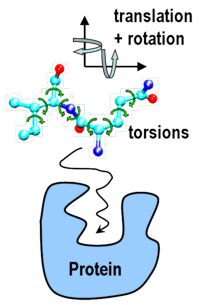Sampling Methods
Sampling the correct bound pose is the first requirement for a successful docking simulation. No matter how good our scoring function is, we cannot report the correct bound pose unless we find it first.
Contents
Anchor and Grow
DOCK uses the Anchor and Growth method to sample the torsions in flexible molecules.
Clash Checking
During growth, some of the molecule conformations produced may be invalid. Clash checks removes unphysical poses. The clash_overlap parameter controls this. By default, the clash_penalty parameter is set to 0.5
if nonbonded_atoms(a1, a2)
ref = clash_penalty * (atom_radius[a1] + atom_radius[a2])
report clash if distance(a1,a2) < ref
Torsion Drive Libraries
max_orientations
The max number of orientations generated in the orienting code, before geometrical clustering.
min_anchor_size
Determines multiple anchor settings
pruning_max_orients
The number of anchor orients passed on to the anchor and grow code. A second clustering is performed in grow_periphery after minimization of the anchors which uses both energy and RMSD diversity. Presumably setting this equal to max_orientations turns off the geometric clustering in the orienting code.
pruning_clustering_cutoff
A parameter that roughly determines the number of conformers retained at each stage of growth after clustering. Default is 100. Greater numbers mean a greater # of conformers retained. Not a hard cutoff though, the number of conformers retained can be much greater at times.
pruning_conformer_score_cutoff
The max score (usually +ve) that will be allowed while pruning minimized conformers during growth. The same value is used for both grid score and internal energy. Typically 50 works well.

